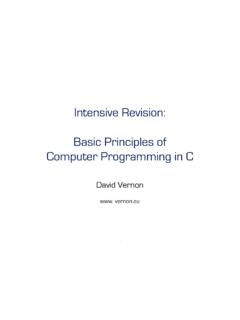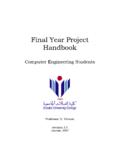Transcription of Introduction to Computer Architecture - David Vernon
1 Copyright 2007 David Vernon ( )An Introduction to Computer SystemsDavid VernonCopyright 2007 David Vernon ( )A Computer .. takes input processes it according to stored instructions produces results as outputCopyright 2007 David Vernon ( )Key Concepts Input: Data Instructions: Software, Programs Output: Information (numbers, words, sounds, images)Copyright 2007 David Vernon ( )Types of ComputerPre-programmedWatchesTraffic SignalsEngine ManagementTelevisionsTelephonesNavigatio n DevicesSpecial Purpose(embedded systems)Can be adapted tomany situationsPersonal ComputersWorkstationsMainframesSupercomp utersGeneral Purpose( user -programmable)ComputerCopyri ght 2007 David Vernon ( )Data vsInformation A 2, 4, 23, 30, 31, 36 A your grade in the exam 2, 4, 23, 30, 31, 36 Next week s Lotto numbersCopyright 2007 David Vernon ( )Key Concepts Codes Data and information can be represented as electrical signals ( Morse code) A code is a set of symbols (such as dots and dashes in Morse code) that represents another set of symbols, such as the letters of the alphabet, or integers or real numbers, or light in an image, for the tone of a violinCopyright 2007 David Vernon ( )
2 Key Concepts A circuit is an inter-connected set of electronic components that perform a function Integrated Circuits (ICs) Combinations of thousands of circuits built on tiny pieces of silicon called chipsCopyright 2007 David Vernon ( )Key Concepts Binary signal (two state signal) Data with two states off & on low voltage & high voltage 0v & 5vCopyright 2007 David Vernon ( )Key Concepts Bit Single Binary Digit Can have value 0 or 1, and nothing else A bit is the smallest possible unit of information in a computerCopyright 2007 David Vernon ( )Key Concepts Groups of bits can represent data or information 1 bit - 2 alternatives 2 bits - 4 alternatives 3 bits - 8 alternatives 4 bits - 16 alternatives n bits - 2nalternativies 8bits -28= 256 alternatives a group of 8 bits is called a byteCopyright 2007 David Vernon ( )4 Bits 0000 0001 0010 0011 0100 0101 0110 0111 1000 1001 1010 1011 1100 1101 1110 1111 Copyright 2007 David Vernon ( )Key Concepts Information System A system that takes data, stores and processes it, and provides information as an output An IS is a Computer in use The amount of data can be vastCopyright 2007 David Vernon ( )Key Concepts Communication System Communication.
3 The transfer of meaningful information Comprises a sender (transmitter) a channel over which to send the data a receiverCopyright 2007 David Vernon ( )Key Concepts Network Two and usually more communication devices connected together Many connection topologiesCopyright 2007 David Vernon ( )Key Concepts Hardware The physical (electronic and mechanical) parts of a Computer or information system Software The programs that control the operation of the Computer systemCopyright 2007 David Vernon ( )Components of Computer SystemsCopyright 2007 David Vernon ( )Components of Computer Systems Keyboard Display System Unit Storage PrinterCopyright 2007 David Vernon ( )Key Components More Formally: Input Output Storage ProcessorCopyright 2007 David Vernon ( )Input SystemsKeyboardINPUT Keyboard Most common input device QWERTYC opyright 2007 David Vernon ( )Input SystemsKeyboardMouseINPUT Mouse Cursor manipulation device TrackballCopyright 2007 David Vernon ( )Input SystemsKeyboardMouseTo uch ScreenINPUT Touch ScreensCopyright 2007 David Vernon ( )Input SystemsKeyboardMouseTouch ScreenPen/StylusINPUT Pens StylusCopyright 2007 David Vernon ( )Input SystemsKeyboardMouseTo uch ScreenPen/StylusMagnetic InkINPUT Magnetic Ink Character Recognition (MICR)Copyright 2007 David Vernon ( )Input SystemsKeyboardMouseTo uch ScreenPen/StylusMagnetic InkBar CodeINPUT Bar Code ReadersCopyright 2007 David Vernon ( )
4 Input SystemsKeyboardMouseTouch ScreenPen/StylusMagnetic InkBar CodeOptical CharacterRecognitionINPUT Optical Character Recognition systems Book readers for the blind Automated input of text Can do typewritten text and handwritten block capital Problems with cursive handwriting recognitionCopyright 2007 David Vernon ( )Input SystemsKeyboardMouseTouch ScreenPen/StylusMagnetic InkBar CodeOptical CharacterRecognitionSensorsINPUT Sensors Digital thermometers Accelerometers Strain gauges (weighing scales) ..Copyright 2007 David Vernon ( )Input SystemsKeyboardMouseTo uch ScreenPen/StylusMagnetic InkBar CodeOptical CharacterRecognitionSensorsCamerasINPUT Camera Systems Surveillance and monitoring Visual inspection Robot guidance Video conferencingCopyright 2007 David Vernon ( )Input SystemsKeyboardMouseTo uch ScreenPen/StylusMagnetic InkBar CodeOptical CharacterRecognitionSensorsCamerasVoiceI NPUT Voice Voice recognition Hands-free car-phones Assistance for the disabledCopyright 2007 David Vernon ( )Key Components Input Output Storage ProcessorCopyright 2007 David Vernon ( )Output SystemsSoft CopyModemDisk or TapeHard CopyOUTPUTC opyright 2007 David Vernon ( )Output Systems Soft Copy Voice synthesis Music CRT (Cathode Ray Tube) LCD (Liquid Crystal Display)VoiceCRTFlat PanelSoft CopyModemDisk or TapeHard CopyOUTPUTC opyright 2007 David Vernon ( )
5 Output Systems Modems Modulator-Demodulator Allows computers to communicate over telephone linesVoiceCRTFlat PanelSoft CopyModemDisk or TapeHard CopyOUTPUTC opyright 2007 David Vernon ( )Output Systems Disks Magnetic Floppy Hard disk Optical Storage DevicesVoiceCRTFlat PanelSoft CopyModemDisk or TapeHard CopyOUTPUTC opyright 2007 David Vernon ( )Output SystemsVoiceCRTFlat PanelSoft CopyModemDisk or TapePlottersMicrofilmNon-impactPrintersI mpact PrintersHard CopyOUTPUTC opyright 2007 David Vernon ( )Output SystemsVoiceCRTFlat PanelSoft CopyModemDisk or TapePlottersMicrofilmNon-impactPrintersI mpact PrintersHard CopyOUTPUTC opyright 2007 David Vernon ( )Output SystemsVoiceCRTFlat PanelSoft CopyModemDisk or TapePlottersMicrofilmLaserMagneticTherma l TransferThermal and ElectrostaticNon-impactPrintersImpact PrintersHard CopyOUTPUTC opyright 2007 David Vernon ( )Output SystemsVoiceCRTFlat PanelSoft CopyModemDisk or TapePlottersMicrofilmNon-impactPrintersD ot matrixLine PrinterImpact PrintersHard CopyOUT PUTC opyright 2007 David Vernon ( )Key Components Input Output Storage ProcessorCopyright 2007 David Vernon ( )Storage Systems Units of Storage 1 bit 8 bits = 1 byte 1kbyte = 210 = 1024 bytes 1 Mbyte = 220= 1048576 bytesTemporaryMEMORYP ermanentMASS STORAGESTORAGEC opyright 2007 David Vernon ( )Storage Systems Memory Stores the bits and bytes (instructions and data) ROM - Read Only Memory Non-volatile Won t disappear when power is off RAM - Random Access Memory Read/Write Memory Volatile SIMMs (Single Inline Memory Modules): 4 Mbytes in a stick of chewing gumROMRAMT emporaryMEMORYP ermanentMASS STORAGESTORAGEC opyright 2007 David Vernon ( )Storage Systems Optical Disks 15,000 tracks per inch Digital code read by laser 650 Mbytes in a plastic platter CD ROM.
6 WORM; Erasable DisksROMRAMT emporaryMEMORYO pticalMagneticPermanentMASS STORAGESTORAGEC opyright 2007 David Vernon ( )Storage Systems CD ROM CD Read Only Memory 12cm optical disk Capable of storing 72 minutes of VHS quality video using MPEG compressionROMRAMT emporaryMEMORYO pticalMagneticPermanentMASS STORAGESTORAGEC opyright 2007 David Vernon ( )Storage Systems Write-One Read_Mostly CDs (WORMS) Powerful laser burns in the digital code Not erasable Lowe power laser reads the digital pattern Eraseable CD Lasers read and write inofrmation Also use a magnetic material To write: a laser beam heats a tiny spot and a magnetic field isapplied to reverse the magnetic polarityROMRAMT emporaryMEMORYO pticalMagneticPermanentMASS STORAGESTORAGEC opyright 2007 David Vernon ( )Storage Systems Magnetic Disk A circular platter coated with magnetic material Floppy Disk ; 360kbyte to ( is common) Hard Disk.
7 120 Mbytes to over 6 Gigabyte (6 Gbyte)ROMRAMT emporaryMEMORYO pticalDiskMemory CardTapeMagneticPermanentMASS STORAGESTORAGEC opyright 2007 David Vernon ( )Storage Systems 40 Gbyte hard disk 20,000,000 pages of text 650 Mbyte CD 325,000 pages of text 17 Gbyte DVD 8,500,000 pages of textROMRAMT emporaryMEMORYO pticalDiskMemory CardTapeMagneticPermanentMASS STORAGESTORAGEC opyright 2007 David Vernon ( )ROMRAMT emporaryMEMORYO pticalDiskMemory CardTapeMagneticPermanentMASS STORAGESTORAGES torage Systems Height of Read Head above magnetic surface 2 millionths of an inch Smoke Particle 250 millionths of an inch Fingerprint 620 millionths of an inch Dust particle 1500 millionths of an inch Human hair 3000 millionths of an inchCopyright 2007 David Vernon ( )The Processor:Hardware & SoftwareCopyright 2007 David Vernon ( )Components of Computer Systems Keyboard Display System Unit Storage PrinterCopyright 2007 David Vernon ( )Key Components Input Output Storage ProcessorCopyright 2007 David Vernon ( )HardwareMicroprocessorMemoryInterface ICsHardwareSoftwareProcessing Unit Microprocessor Effects computation Intel 80486, 80586 Motorola 68040 PowerPC, MIPS, Alpha, Sparc Clock speeds 50-600 MHz (+) Memory Storage Interface ICs communication with other devicesCopyright 2007 David Vernon ( )HardwareMicroprocessorMemoryInterface ICsHardwareSoftwareProcessing Unit Much more to come on the topic of hardware shortlyCopyright 2007 David Vernon ( )SoftwareOperatingSystemsProgrammingLang uagesSystem SoftwareGeneralPurposeSpecialPurposeAppl ication SoftwareSoftwareCopyright 2007 David Vernon ( )
8 Operating Systems user interfaces Software which is responsible for passing information to and from the person using the program (the user ) Communicates with and controls the Computer Three types of user interface: Graphic user interfaces Menu driven interfaces Command driven interfacesOperatingSystemsProgrammingLan guagesSystem SoftwareGeneralPurposeSpecialPurposeAppl ication SoftwareSoftwareCopyright 2007 David Vernon ( )Operating Systems Graphic user Interfaces (GUIs) Pictures, graphic symbols (icons), to represent commands Windows: a way of looking in on several applications at onceOperatingSystemsProgrammingLanguages System SoftwareGeneralPurposeSpecialPurposeAppl ication SoftwareSoftwareCopyright 2007 David Vernon ( )Operating Systems Menu-driven interfaces Menu bar Pull-down menu for choicesOperatingSystemsProgrammingLangua gesSystem SoftwareGeneralPurposeSpecialPurposeAppl ication SoftwareSoftwareCopyright 2007 David Vernon ( )Operating Systems Command-driven interfaces A (system) prompt user types in single letter, word, line which is translated intoan instruction for the Computer For example.
9 Cp source destination Need to be very familiar with the syntax (grammar) of the command languageOperatingSystemsProgrammingLangu agesSystem SoftwareGeneralPurposeSpecialPurposeAppl ication SoftwareSoftwareCopyright 2007 David Vernon ( )SoftwareOperatingSystemsProgrammingLang uagesSystem SoftwareGeneralPurposeSpecialPurposeAppl ication SoftwareSoftwareCopyright 2007 David Vernon ( )Operating Systems Operating System is the software that manages the overall operation of the Computer system Main purpose is to support application programs Hide details of devices from application programsCopyright 2007 David Vernon ( )Operating Systems Shell (or user interface) Network interface: coordinate multiple tasks in a single Computer Task schedulercoordination of multiple tasks in a single Computer Kernel Software which ties the hardware to the software, and manages the flow of information to and from disks, printers, keyboards, .. all I/O devicesShellNetwork I/FTaskSchedulerKernelOperatingSystemsPr ogrammingLanguagesSystem SoftwareGeneralPurposeSpecialPurposeAppl ication SoftwareSoftwareCopyright 2007 David Vernon ( )Operating Systems File Handling Collection of information (stored on disk) Disks need to be formatted to allow them to store information OS manages location of files on disk OS performs I/O to disk OS checks and corrects errors on disk I/OCopyright 2007 David Vernon ( )Operating Systems Device Drivers Programs which handle the various hardware devices, , mouse, keyboard, CD, video, etc.
10 For example, an application wants to print a document It call the operating system which sends the information to the device driver together with instructions and the printer driver handles all the control of the printer Copyright 2007 David Vernon ( )Operating Systems Single tasking OS Runs only one application at a time Multi-Tasking OS More than one application can be active at any one timeCopyright 2007 David Vernon ( )Operating Systems DOS (Disk Operating System) Single-tasking Command-driven Huge number of applications written for DOS Does not require powerful Computer No network services No multimedia extensions Designed for the Intel 80x86 processorCopyright 2007 David Vernon ( )Operating Systems Windows GUI Can run DOS programs Has network services Has multimedia extensions Requires large amounts of memory, disk space, powerful processor Designed for the Intel 80X86 processorsCopyright 2007 David Vernon ( )Operating Systems Macintosh OS Multi-tasking GUI called finder Very easy to use Very graphically oriented Has network services Has multimedia extensions Designed for the Motorola and PowerPC processorsCopyright 2007 David Vernon ( )Application Software Special Purpose Payroll Accounting Book-Keeping Entertainment Statistical AnalysisOperatingSystemsProgrammingLangu agesSystem SoftwareGeneralPurposeSpecialPurposeAppl ication SoftwareSoftwareCopyright 2007 David Vernon ( )Application SoftwareOperatingSystemsProgrammingLangu agesSystem SoftwareGeneralPurposeSpecialPurposeAppl ication SoftwareSoftware General Purpose Word Processing ( MS Word) Desktop Publishing ( Quark Xpress)



